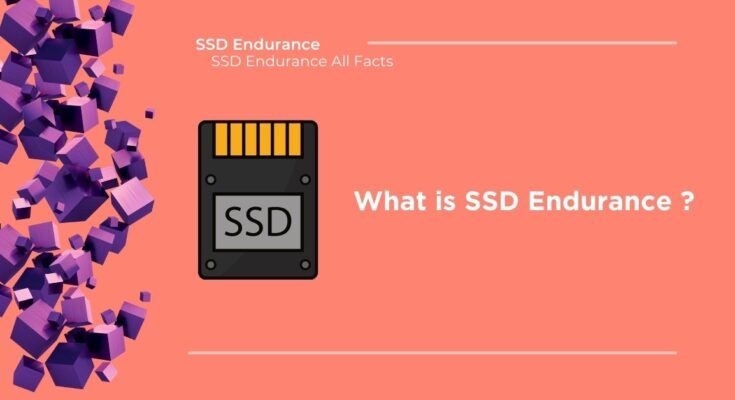Table of Contents
Solid State Drives (SSDs) have quickly become a popular storage option because of their speed and reliability. But one thing that often confuses people is SSD endurance. What is it? How long will my SSD last? And, most importantly, how can I make sure my SSD lasts as long as possible? In this post, we’ll answer all those questions and more. So if you’re curious about SSD endurance, keep reading!
What is SSD Endurance??
Simply put, SSD endurance refers to how many program-erase (P/E) cycles a given memory block can sustain before it becomes unreliable. In an SSD, each memory block contains a microcontroller that keeps track of P/E cycles. If this microcontroller detects a specific number of P/Es has been reached for a certain memory block, the controller will flag the data as being unreliable and replace it with fresh data from another region of the drive .
The maximum quantity of data that an SSD can write under warranty is known as endurance. When it comes to technicality, many individuals may not comprehend SSD endurance. Simply stated, the faster you’ll have to replace your drive, the lower its endurance is.
If you pick an SSD with the incorrect endurance, you’ll either have to replace it or overpay for a drive with greater endurance.
Why you should care about SSD endurance
If you’re planning on using an SSD for heavy workload applications, like video editing or running virtual machines, then endurance is something that you’ll need to take into consideration.
However, if you’re using your drive for daily computer use, then endurance is probably not something you’ll need to worry about – especially since most people will never write enough data in their lifetime to make endurance a factor.
What is SSD Write Cycle Count?
Write Cycle Count is the number of times your Solid State Drive can be written to. If you are using a computer for basic tasks such as surfing the web, checking emails, and listening to music then this should not matter because it will not be written on very often.
But if you are using this for intensive files like video editing or playing games, then Write Cycle Count would become important so you can know how long it will last. There are two types of SSDs: MLC (Multi-Level Cell) and SLC (Single-Level Cell). SLC is more durable than MLC since each cell has only 2 values but with MLC it contains 4 values which make it less durable than SLC.
What factors affect Endurance?
There are two major factors that impact the endurance of an SSD: how much data each cell can handle before it becomes unreliable; and how many cells are used per memory block (GB). The former refers to the physical limitation of the NAND cells themselves while the latter describes how they’re configured in memory blocks.
To start, each NAND cell can only withstand a certain number of P/E cycles before it becomes unreliable. While the amount varies depending on the type of NAND used in your SSD, most manufacturers will put that number somewhere between 3k and 10k P/E cycles per cell.
Next, you’ll need to multiply that number by the total number of cells in a memory block (usually anywhere from 8-64). This gives you a rough idea of how many program-erase cycles a given block can sustain before becoming unreliable. Lastly, some SSDs have the spare capacity within their blocks which is used as an extra reserve for those cells that become unreliable first.
Understanding the different types of SSDs and their lifespan
Types of SSDs and their Lifespan
Your first decision when it comes to buying an SSD is whether you want a SATA, SAS or PCIe drive. Since we’ve already covered those differences in previous articles and videos, we won’t go into too much detail here (for more info, check out our video on MLC vs SLC).
However you choose to configure your solid-state storage, the same rules for endurance apply: more cells mean greater reliability; having spare capacity within each block helps those cells that become unreliable first.
How to increase your SSD’s durability with proper care
The easiest way to maximize your SSD endurance is to avoid doing anything that will cause your drive stress – especially writing large amounts of data – unless you have to. Other than that, you should choose an SSD with the lowest endurance possible – preferably one that includes extra reserve capacity – for your intended use.
How to know when it’s time for a new one…
Well, that’s another topic entirely. Even with the best care, you will still need to replace your SSD at some point. How soon you need to do this will depend on how much data you’re writing, what type of NAND it uses, and its overall capacity. If you’re experiencing any issues following these guidelines then it may be time for a replacement.
How to protect yourself from buying bad endurance-rated SSDs
Now that we’ve covered why endurance matters and how much is enough, the question remains: How can you avoid buying an SSD with inadequate endurance? This largely depends on which particular model/capacity of the drive you want so I recommend researching a bit.
What Will Happen If SSD Endurance Is Chosen Wrong?
This will depend on how much data you’re writing. If the drive is only intended for light usage, then it probably won’t become too unreliable until long after its printed endurance rating or warranty has expired. But if you are using this for intensive files like video editing or playing games, then Write Cycle Count would become important so you can know how long it will last.
Do SSD Last Longer Than HDD?
SSD lasts longer than HDD. This is because the mechanical nature of portable storage (HDD) means that there’s a high chance your drive will fail if you’re not careful with it. On the other hand, an SSD is solid-state and, as such, there isn’t much to go wrong inside it – except for the endurance itself which we’ve already covered in this article.
How many years can you use an SSD?
On average, 50-75% of initial cell capacity is lost after one year; and 30-50% after three years. But since manufacturers rate their drives based on how much data they can hold when new, that rating doesn’t actually reflect what you’ll get from your memory block until several P/E cycles have been completed.
This wear-out period is dependant on the type of NAND used and can vary from manufacturer to manufacturer. Most drives will last between 3-5 years before you start experiencing problems but this will be shorter for intensive applications like editing videos or playing games.
How To Check SSD Life
Many producers provide free SSD health monitoring tools. The following are the brands and the corresponding software available:
- Samsung – Samsung Magician
- Intel – Intel SSD Toolbox
- OCZ – OCZ SSD Utility
- Crucial – Crucial Storage Executive
- Kingston – Kingston SSD Manager
If the SDD maker doesn’t provide a free utility, you may use a third-party tool that works with most SSDs like SSD Life or SSDReady.



